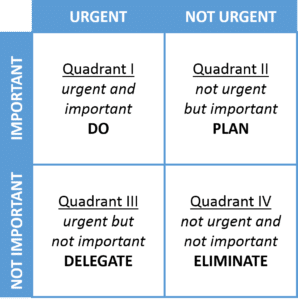How to Motivate Your Team to Get More Done at Work
June 19, 2019 | People Management | No Comments

Dear CFO,
Our company’s owner just handed me a long list of quarterly priorities for the department that I lead. I would like to implement some of my own priorities as well this quarter, to help our department run more efficiently. How can I motivate my team to get more done at work? I want to accomplish both sets of priorities, and still get the day-to-day work done. My fellow team members don’t have much extra time and our department doesn’t have room in the budget for outside help. How can I achieve more so we hit our targets?
Trying to Meet Objectives in Boston
As I read your question, my first thought is, “I’ve been there!”
Often it feels as though company priorities are set in a vacuum; totally ignoring the day-to-day reality of staffing and the allocation of other resources. In my experience, while it often feels that way at the department level, it’s not usually the case. My guess is that your company owner is prioritizing a dizzying array of objectives for both the long-term benefit of the company and to meet short-term constraints, such as cash flow.
Unfortunately, the onus is on the department heads to ensure their team stays productive. You may feel like you don’t have a clear path to get more done at work but are still facing constant pressure to make it happen. Team members need buy-in and engagement in the work they do, including company and department priorities (unless you run a department of cyborgs). This engagement is critical for fueling motivation.
While I agree in principle with the best practice that says every goal for every individual and department should align with the top goals of the company, the truth is, it’s not always realistic.
Individual team members will have day-to-day aggravations, roadblocks, or impediments that they feel need to be a quarterly priority as well. While the direct correlation with an individual’s goal and a company goal may not be evident, addressing these challenges (and helping your team address them) will be reflected in employee performance and retention. Therefore, I believe that employees can have priorities not directly tracked to the company goals that will still contribute to effectiveness, efficiency, and overall job satisfaction.
How to Accomplish Company Priorities
The big (not-so) secret to getting more done at work is fostering employee engagement and buy-in. The question then becomes how do you get the buy-in from your team, so you can keep your boss happy and satisfied with your department?
First, to build employee buy-in, focus on the many ways the company priorities benefit your department. Underscore the importance and the impact of proposed priority projects on the individual members of the team, the department as a whole, and of course, the company.
It’s often hard for individuals in the company to see the bigger picture (and feel that it indeed justifies additional effort), so it is important you understand the benefit of each objective and can exuberantly support them. If there is not a direct benefit to workers, it’s important for team leaders and department heads to convey the overall importance to the company just as exuberantly. This doesn’t mean you should ignore your team’s objections or frustrations, but rather that you should prepare to address them directly.
Being prepared to speak to team members’ objections requires you to think and empathize with the individuals in your department. Like all of us, team members have a unique perspective, viewed from their own lens of experience. Therefore, it’s helpful to address the goals in terms of each perspective (and each concern). This means answering the big question WIIFM (“What’s in it for me?!”). Candid honesty is the best policy to address concerns. If there is truly no direct benefit to team members, say so, but within the context of “why” the priority exists.
Address direct impacts of the company priorities such as:
- Changes in department workflow – for example, expense reports may now be verified in your department.
- Changes in department staffing – for example, headcount getting cut due to the automation of a process.
- Changes in department priorities – for example, new computer upgrades are getting fast-tracked.
- Changes in individual roles and/or responsibilities – such as increased involvement in the expense reporting function requires training for additional processing.
- Need for additional hours – for example, when training on a new system adds time to the workday, necessitating overtime.
- Changes in scheduling – for example, a new system implementation requires weekend work from your team.
No matter the scenario, changes should be explained and concerns addressed clearly. Ambiguity is often demotivating. Team members can’t see the benefit or rationale for the actions of the “man behind the curtain.” This leads to distrust and frustration.
Instead, operating with transparency (even when it’s not the greatest news) will help your team get more done at work. They’ll feel engaged and appreciated. Even if a task is difficult or challenging, understanding the greater “why” helps justify the effort.
How to Accomplish Department & Team Priorities
Much the same as setting company priorities, department priorities should be set using specific criteria.
When it comes to setting department priorities, filtering ideas through what Stephen Covey referred to as the “Four Quadrants” will help. For those unfamiliar, each priority and idea can be filtered from the team based on their sense of urgency and importance.
Quadrant 1: Urgent/Important
Quadrant 2: Important/Not Urgent
Quadrant 3: Not Important/Urgent
Quadrant 4: Not Important/Not Urgent.
Most priorities for the team to address should come from quadrants 1 and 2. Keep in mind, the sense of urgency and importance of the team members’ ideas may be different from your own, so it’s important to work together to set goals. Some goals may also differ from what the company would deem as quadrant 1 or 2 goals. Yet team members may need to accomplish some of their own objectives to even make it possible to achieve the company goals. (For example, accounts payable might have some ideas to quicken their process, enabling them to take on the new expense report processing without adding staff.)
In my experience, there are a few specific best practices that have helped me get more done at work, accomplishing priorities in both levels—company and team/department. The biggest is encouraging employees to take ownership of the various objectives and priorities. This means assigning a leader.
We all know if a task is everybody’s job, it quickly becomes nobody’s job. As the parable, “Who’s Job Is It Anyway” goes:
There are four people named Everybody, Somebody, Anybody and Nobody. There was an important job to be done and Everybody was sure that Somebody would do it. Anybody could have done it, but Nobody did it. Somebody got angry about that, because it was Everybody’s job. Everybody thought Anybody could do it, but Nobody realized that Everybody wouldn’t do it. It ended up that Everybody blamed Somebody when Nobody did what Anybody could have.
Assigning ownership increases buy-in and engagement. From there, accomplishing the team priorities and company priorities entail:
-
- Vetting the capabilities of each team member and aligning them to tasks. Ensure a clear project plan, milestones, and specific outcomes and align them to specific members of the team (the most closely aligned should ideally be the project lead/owner).
-
- Allowing team members to suggest improvements and processes, even if they affect other roles. However, the team members work under the rule, “you can’t make your job easier if it makes my job harder.” When a conflict arises, the team should agree to change the process (ultimately making both jobs more efficient) or to agree upon the transfer and even disbursement of work, based on the overall benefit.
-
- Fully cross-training team members to take on additional roles for an agreed-upon time, so a fellow team member can work on a priority. This not only keeps the cross-trained skills fresh but also encourages team building.
-
- Providing team members with quiet time. Interruption after interruption punctuates the day-to-day work. Whether interruptions come in the form of outside phone calls, social media, Slack, or email, the costs of constant interruptions are high. Giving team members a ½-day of quiet, focused work time per week will greatly improve productivity. This allows your team to get work done, either in the performance of daily tasks to free up time for the quarterly objectives or establishing the quiet time to work on the quarterly priorities themselves.
-
- Providing guidelines for following the process of priorities as well as the level of review and oversight team members should expect. Whether you are using EOS (Entrepreneur Operating System), SMART goals, or other management tools, make sure your team knows the expectations and the timeline for performing them. Transparency and clarity will motivate them along the way.
-
- Keeping an Idea Register with SWAG (“Sophisticated Wild @SS Guesses,” for those of you who are not familiar with the term) estimates of time to complete each task. A Micro-project may be <10 hours and could easily fit into the schedule, whereas a macro project >250 hours generally requires coordinated efforts between departments, higher approval, and a full evaluation of cost/benefit, etc. The idea register keeps visibility on great ideas as they pop up and provides the ability to review the ideas as departmental and company objectives are set.
Since you mentioned the need to follow budget constraints, another option to justify the cost of outside help could come from a good cost/benefit analysis. I recently justified the benefit of a temp because the work she picked up would free my controller and that would take work off my plate (and I am an hourly CFO).
It’s certainly possible to get more done at work and to motivate your team with strategic planning and by fostering engagement. Remember, cracking the whip and pushing your team to accomplish more and more, without transparency or buy-in, becomes demotivating. Get everyone on the same page.
Accomplishing company (and department) priorities requires inter-departmental cooperation, great leadership, appropriate delegation, and independence…along with good processes to manage the projects. If you have been providing good leadership to your department and you have an engaged team, I am sure that you can accomplish both the company goals as well as the departmental.
Featured image and post images licensed via Burst.





